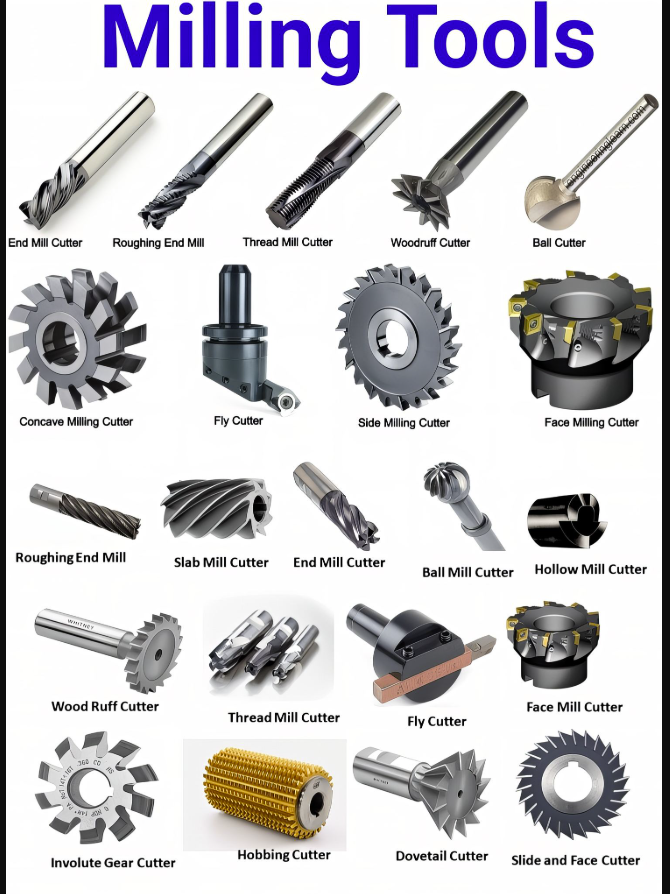Milling tools (or cutters) are used in CNC machines and manual milling machines to remove material from a workpiece. The choice of tool depends on the material, desired finish, and machining operation. Below is a breakdown of common milling tools and their uses.

1. End Mills
Primary Use: General-purpose milling (slotting, profiling, contouring).
Types & Applications:
-
Flat End Mill: Square tip for 2D/3D milling (most common).
-
Ball Nose End Mill: Rounded tip for 3D contouring and smooth finishes.
-
Corner Radius End Mill: Slightly rounded edges to reduce chipping (better durability than flat end mills).
-
Roughing End Mill (Rougher): Serrated edges for rapid material removal.
-
Long Reach End Mill: Extended neck for deep cavities.
Materials:
-
HSS (High-Speed Steel): General-purpose, cost-effective.
-
Carbide: Harder, longer-lasting, better for metals.
-
Cobalt: Heat-resistant, good for stainless steel.
2. Face Mills
Primary Use: Facing large flat surfaces.
Features:
-
Multiple replaceable carbide inserts.
-
High material removal rate.
-
Used for roughing and finishing.
3. Slot Drills (Slot Mills)
Primary Use: Cutting precise slots and keyways.
Features:
-
Two or three flutes for better chip evacuation.
-
Can plunge-cut like a drill bit.
4. Fly Cutters
Primary Use: Smooth finishing on large flat surfaces.
Features:
-
Single-point cutting tool.
-
Cost-effective for low-volume work.
5. Shell Mills
Primary Use: Heavy-duty face milling.
Features:
-
Large diameter with multiple inserts.
-
Used in industrial machining for high-speed material removal.
6. T-Slot Cutters
Primary Use: Cutting T-slots for fixtures and workholding.
Features:
-
Specialized profile to create T-shaped grooves.
7. Dovetail Cutters
Primary Use: Milling dovetail grooves (common in tooling and fixtures).
Features:
-
Angled cutting edges (typically 45° or 60°).
8. Thread Mills
Primary Use: Cutting internal or external threads.
Features:
-
Can produce threads in a single pass (unlike taps).
-
More versatile than tapping (same tool can make different thread sizes).
9. Chamfer Mills
Primary Use: Beveling edges (deburring or preparing for welding).
Features:
-
Angled cutting edges (common angles: 45°, 60°, 90°).
10. Woodruff Keyseat Cutters
Primary Use: Cutting keyways for shafts.
Features:
-
Small, specialized cutter for precise slots.
11. Hollow Mills
Primary Use: Turning operations on milling machines (like a form tool).
12. Drill Mills (Combination Tools)
Primary Use: Drilling and light milling in one tool.
Choosing the Right Milling Tool
| Operation | Recommended Tool |
|---|---|
| Facing | Face Mill, Fly Cutter |
| Slotting | End Mill, Slot Drill |
| Contouring | Ball Nose End Mill |
| Threading | Thread Mill |
| Chamfering | Chamfer Mill |
| Heavy Roughing | Roughing End Mill, Shell Mill |
| T-Slots | T-Slot Cutter |
Material Considerations
-
Aluminum: High helix end mills for better chip evacuation.
-
Steel: Carbide tools with coatings (TiN, TiCN).
-
Plastics: Sharp, polished flutes to prevent melting.
-
Hardened Metals: Solid carbide or diamond-coated tools.
Key Factors When Selecting a Milling Tool
-
Material (workpiece & cutter).
-
Operation (roughing, finishing, slotting, etc.).
-
Tool Coating (TiN, TiAlN for heat resistance).
-
Flute Count (more flutes = smoother finish, fewer flutes = better chip clearance).
